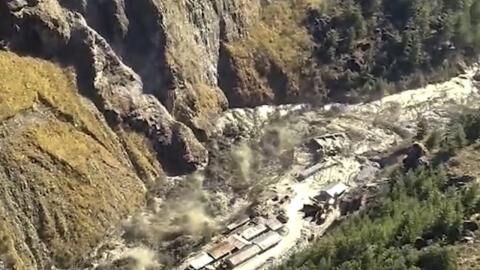People left Goma, in the eastern Democratic Republic of Congo, evacuating the city because of a new eruption, and risks of lava flows in the city. Military governor of the province of North Kivu, in the east of the Democratic Republic of Congo, General Constant Ndima, said at dawn in an address to the population:
Discover our latest podcast
The current seismic and ground warping data indicates the presence of magma under the urban area of Goma, with an extension under Lake Kivu.
General Ndima, then cited the names of ten districts of the city that must be evacuated:
We cannot currently rule out an eruption on land or under Lake Kivu, which could happen very soon, or even without any warning.
'There's fear, there's panic, everyone is fleeing,' one resident confessed shortly after the announcement, which prompted tens of thousands of people to flee to the town of Sake, west of Goma, and the nearby Rwandan border.
'The volcano may erupt'
'The situation is complicated, it is better to leave the city because nobody seems to be in control,' said a resident, Alliance Kimony. 'We are afraid, at any moment the volcano can appear in any place without choosing. It is better to leave.'
A few hours later, at the end of the morning, there were still huge traffic jams and a rush at the southern exits of Goma, but a relative return to calm in the streets of the city centre, where few shops were open, and where, for example, a dozen people were queuing in front of a bank that remained closed.
Additional risks are linked to the interaction between the lava and the water of the lake.
The governor warned of a disaster scenario, well known and identified for Lake Kivu, of a risk of destabilisation of the gas under the lake ('limnic eruption,' as specialists call it).
The risks are of several kinds: interaction of magma with the water of the lake, destabilisation of the volume of gas dissolved under Lake Kivu and emission of potentially dangerous surface gases.

The governor added:
The situation can change rapidly, it is under constant surveillance [...] in anticipation of this possible disaster, evacuation is compulsory and will be done towards Sake (a locality 20 km west of Goma)
In a statement from Kinshasa, the Ministry of Communication also justified:
The persistent threat of eruption and repeated seismic tremors oblige the government to activate a plan for the progressive evacuation of the inhabitants as soon as possible (...)
Calling for calm, the authorities say they have made transport available and deployed police patrols 'to secure goods and people.'
But where are the efforts?
A fugitive, Agnès Kahindo, lamented on the road to Sake:
We are astonished. We don't see these means of leaving Goma, there are too many traffic jams, the prices of motorbike taxis are exploding.

The streets in the southern part of Goma were immediately swamped and congested, with people walking, jogging or running, carrying mattresses, sports bags or a few meagre possessions in plastic bags, holding hands with frightened children to prevent them from getting lost.
At Goma's port, it was also a rush. Crowds were rushing to board boats bound for Bukavu, in southern Kivu, where thousands of displaced people are gradually arriving via the lake or the road. In the morning, the authorities banned navigation on the lake, probably for fear of an overloaded boat capsizing.
People were also fleeing north of Goma, via Rutshuru, taking by the thousands and mostly on foot the road cut off in that direction by Saturday's lava flow.
Goma has more than 600,000 inhabitants, for a population centre of two million people, according to the administration.

The ten districts of Goma evacuated on Thursday are 'exposed to lava outlets, which are not foreseeable at the moment,' according to Governor Ndima.
So far, 32 people have died since the eruption on Saturday.
The previous major eruption of Nyiragongo, on 17 January 2002, killed about 100 people. Nyiragongo's deadliest eruption killed more than 600 people in 1977.















